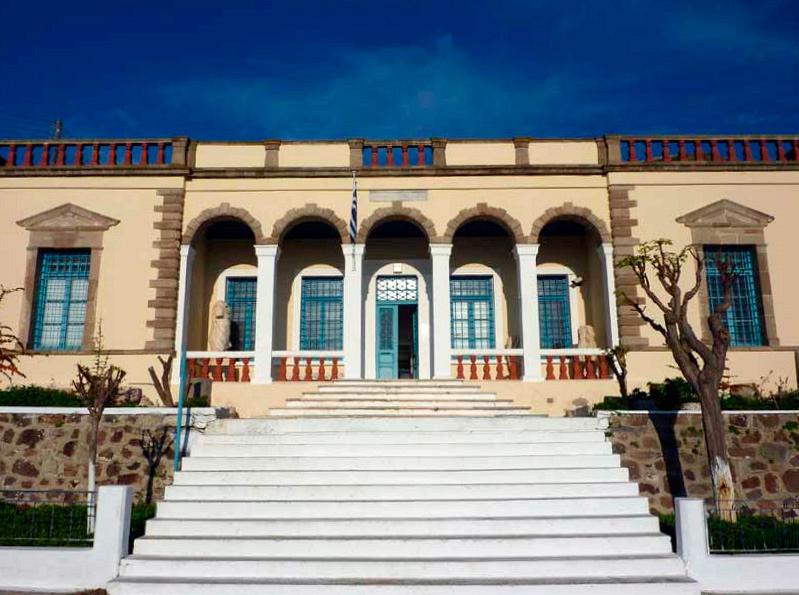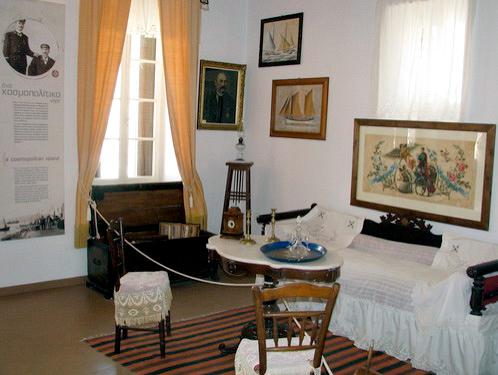Milos today
Milos can be reached by air or sea, through daily schedules. The island provides tours and excursions by car or small craft; it has interesting natural sights and Museums, while traditional feasts and events are being organized throughout the year by local cultural bodies.
Conference tourism
 “Milos Conference Center George Eliopoulos” is located near Adamas, in an area of 1 hectare. It has been designed to operate throughout the year, and it has been equipped according to the latest modern specifications. Apart from the conference rooms, with total capacity of 320 participants, there are administration offices, a special Press room, an Internet room, a fully equipped surgery, parking lots for 100 cars and security fencing. It is fully air-conditioned, with complete fire-protection system, while all facilities are accessible to the disabled. In addition, its perfect technological support provides comprehensive services to conference participants, through modern audiovisual and telecommunication means.
“Milos Conference Center George Eliopoulos” is located near Adamas, in an area of 1 hectare. It has been designed to operate throughout the year, and it has been equipped according to the latest modern specifications. Apart from the conference rooms, with total capacity of 320 participants, there are administration offices, a special Press room, an Internet room, a fully equipped surgery, parking lots for 100 cars and security fencing. It is fully air-conditioned, with complete fire-protection system, while all facilities are accessible to the disabled. In addition, its perfect technological support provides comprehensive services to conference participants, through modern audiovisual and telecommunication means.
Tel.: (+30) 22870 23850
Local feasts
The inhabitants of Milos, loyal to their customs and traditions, are inviting you to attend feasts and events where you will have the chance to taste traditional food and local wine, to dance and have fun under the sounds of popular island music.
Dates of local feasts:
| 50 days after Easter at Aghia Trias (Holy Trinity), in Adamas |
| June 30 at Aghioi Anargyroi |
| July 6 at Aghia Kyriaki |
| July 16 at Saint Marina, in Chalakas |
| July 19 at Prophet Elias, in Chalakas and Komia |
| July 21 at Saint Markella, in Kipos |
| July 25 at Saint Paraskevi, in Pollonia |
| July 26 at Saint Pandeleimon, in Plakota and Korfos |
| July 31 Procession of Holy Cross, in Golgotha, Plakes |
| August 5 the Transfiguration, in Parasporos |
| August 14 at the Dormition of the Virgin, In Zephyria |
| August 15 at the Dormition of the Virgin or St. Charalambos, Adamas |
| August 17 at Saint Floros, in Komia |
| August 22 at Panaghia Giatrissa (Our Lady the Healer), in Komia |
| August 22 at Panaghia (the Virgin) of Kipos |
| August 22 at Panaghia Faneromeni (Our Lady who appeared), in Trypiti |
| August 26 at Saint Phanourios, in Pollonia |
| August 28 at Saint John the Baptist, in Agrilies and Provatas |
| August 29 at Saint Alexander, at Katsoulis’ place |
| August 31 at Pantocrator, in Mytakas |
| September 6 at Saint Sostis, in Provatas |
| September 7 at Panaghia Eleoussa (the Charitable Virgin), in Psathadika |
| September 8 at Panaghia Korfiatissa, in Plaka |
| September 13 the Exaltation of the Holy Cross, in Kaneria |
| September 16 at Saint Sophia, in Chalakas |
| September 25 at Saint John, in Chalakas |
Milos Festival
 The Cultural Milos Festival is held every summer with great success; S&B Industrial Minerals S.A. was the original founder of the Festival, 11 years ago. In recent years it is organized by the Municipality of Milos, with S&B being the major sponsor. The Milos Festival, along with music events, includes also art events and theater performances, held on several sites of the island.
The Cultural Milos Festival is held every summer with great success; S&B Industrial Minerals S.A. was the original founder of the Festival, 11 years ago. In recent years it is organized by the Municipality of Milos, with S&B being the major sponsor. The Milos Festival, along with music events, includes also art events and theater performances, held on several sites of the island.
The Milos Catacombs
 Source: www.ecclesia.gr |
The catacombs, a paleochristian cemetery on the island of Milos, are situated in the area of the present-day hamlet of Trypiti. They were probably founded at the end of the 2nd century AD and, according to surviving inscriptions as well as the ornaments on several graves, it seems that they were used as burial grounds until the end of the 5th century. The wider area of Trypiti is full of caves, carved in the porous volcanic rock, that were used by the island’s population in antiquity as family funeral chambers. The catacombs were known to the locals as “the Greek Cave”. In 1844, archeologist Ludwig Ross, then the French archeologist Charles Marie Adolphe Louis Bayet in 1878 and later Georgios Lampakis in 1907 visited the catacombs that were subsequently studied systematically by Professor Georgios Sotiriou.
The catacombs in their present-day configuration constitute a network of three large underground galleries, interconnected through artificial passages that were opened up in the 20th century. Each of the three large galleries is also connected to smaller ones, as well as to a recently constructed chamber. In addition to the graves that were carved in the rock walls, there is also a large number of rock-cut tombs in the floor, covered with untreated plaques of unequal size.
Excerpt from a larger text by archeologist Niki Tselenti-Papadopoulou
Useful information:
2η 2nd Ephorate of Byzantine Antiquities
Trypiti, Milos, Prefecture of Cyclades
Admission: Full price: €2, Concessions: €1
Telephone: +30 22870-21625
Source: http://odysseus.culture.gr
Milos Archeological Museum
The Milos Archeological Museum, in Plaka, is housed in a beautiful neoclassical building designed by the famous German-Greek architect Ernst Ziller. One can admire a number of very interesting exhibits:
• A prehistoric collection from Fylakopi
• A Sculpture and Bas-relief collection
• An obsidian collection
• A collection of inscriptions.
Useful information:
Opening hours: 8:00-15:00; Mondays closed
Admission: Full price: €3, Concessions €2 (over 65), free for students and children under 10
Telephone: +30 22870-21620
Source: www.milos.gr
Historical and Folklore Museum of Milos
Behind the church of Panagia Korfiatissa, in Plaka, one can find the Historical and Folklore Museum of Milos. It was created in 1967 by the “Association of Milos islanders in Athens” and presents aspects of everyday life on Milos after the 17th century, and mainly between 1850 and 1930, which was the island’s heyday.
Useful information:
Opening hours: Tuesday-Saturday: 10:00-14:00 & 18:30-21:30, Sunday: 10:00-14:00; Mondays closed
Admission: Full price: €3, Concessions: €1.5 (children and students)
Contact person: Ms Tzina Grigoriou
Telephone: +30 22870 21292, +30 22870 28121, +30 6937693794
Source: www.milos.gr
Ecclesiastical Museum-Reliquary of Agia Triada
The church of Agia Triada, very close to the harbor of Adamas, houses the Ecclesiastical Museum. This thousand-year-old church is characterized, from an architectural point of view, as a “cruciform three-ailed basilica with dome-vault”. This type of church is extremely rare (there is only one more of the same type to be found in Levidi, Prefecture of Arcadia, in the Peloponnese) and is architectonically very interesting: it consists of three aisles, while the cupola, in the same shape as the church itself, was raised laterally to the length of the building.
Useful information:
Opening hours: every day 09:15-13:15 & 18:15-22:15
Admission: Free
Contact person: Mr. Grigoris Belivanakis (milosbel@otenet.gr)
Telephone: +30 22870-23956.
Source: www.milos.gr
Nautical Museum of Milos
The Museum opened to the public in September 2008 and is housed in the old Municipality building, on the harbor’s front. It was created thanks to the tireless efforts of one of the island’s doctors, Petros Armenis, who collected a large number of exhibits relating to the nautical traditions and activities of Milos. Exhibits cover the whole period of the island’s habitation from prehistory, such as obsidian tools, to historical times, such as exhibits from the naval battle of Salamis, and all the way to the modern era.
In the Nautical Museum one can see rare maps and portolan charts, drawn by expert map makers, as well as “Irini”, a famous wooden dinghy.
Useful information:
Opening hours: 18:00-22:00
Telephone: +30 22870-22013
Source: www.milos.gr
Kimolos Archeological Museum
The Kimolos Archeological Museum is situated in the center of the village, opposite the Church of Panagia Odigitria. It is housed in a traditional building, one of the village’s oldest, and opened to the public in 2006.
The first floor is dedicated to the island’s ancient history, starting from the Upper Neolithic; the exhibition includes numerous objects and text panels; a short film is projected regularly. The reconstruction, under a transparent floor board, of an ancient tomb as it was discovered is the most impressive exhibit.
Pictures from an invitation of the Kimolos Archeological Museum
Source: www.gokimolos.gr
Useful information:
Opening hours: Tuesday-Sunday, 08:30-15:00;
Mondays closed
Telephone: +30 22870-51291
Fax: +30 22870-51719
Thermal Baths
Milos, thanks to its volcanic make as well as to its post-volcanic hydrothermal activity, is blessed with many thermal baths, famous since antiquity for their medicinal, therapeutic and curative actions.
Hippocrates, in the Fifth Book of “Epidemics”, mentions the full recovery of an eminent Athenian who suffered from skin disease, after visiting the Lakkos Baths on Milos. Another mention of the island’s therapeutic potential is by Joseph Pitton de Tournefort, a famous French botanist, in his traveler’s texts written in 1771.
The island is host to numerous hot springs with different temperatures and water composition.





